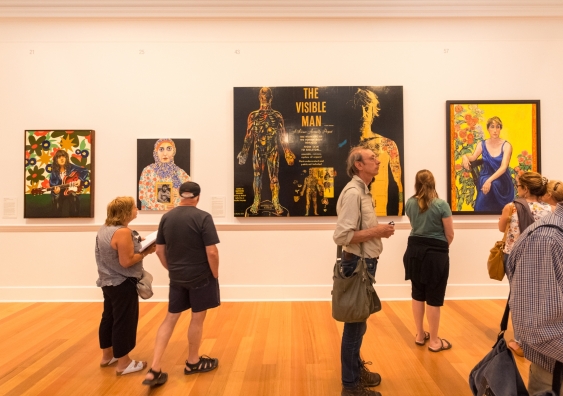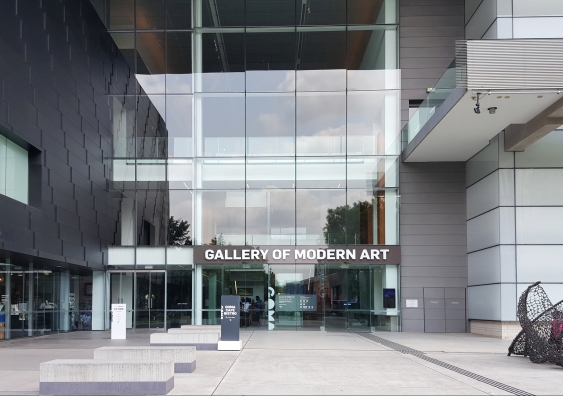Bold cultural visions can be useful for society and give certainty to the arts sector, says UNSW cultural data expert.

Cultural policies can ensure access to arts, which is good for our wellbeing and health. Photo: Shutterstock.
The federal government recently announced a new National Cultural Policy for Australia, with further details to come as part of the federal budget in May.
The National Cultural Policy, titled Revive, will be implemented over a five-year period and it aims to “renew and revive Australia’s arts, entertainment and cultural sector.”
This is Australia’s third ever cultural policy and so, you might be wondering: what exactly is the purpose of a cultural policy?
“We’ve had a cultural policy vacuum on a national level for over a decade and this new policy picks up on this, as well as addressing post-pandemic discontent in the arts,” says Dr Scott East, lecturer in museum studies and expert in cultural data from the UNSW School of Art & Design. Dr East also made a submission to the formation of the National Cultural Policy.
“When they work well, cultural policies can facilitate an important vision – bringing the entire arts sector together to work towards something bold and exciting.”
What makes a cultural policy successful?
Cultural polices are strategies and actions governments take to promote and support Australia’s cultural activities and industries in areas like film, theatre, music and museums. Such strategies and actions can include funding, legislation and creating ministries and independent bodies.
“Cultural policies can play an important role in shaping and promoting Australian identity,” says Dr East. “They can also nurture the creativity of domestic talent and help increase access and participation of everyday citizens in cultural activities.”
Given that cultural policies vary from country to country and depend on society’s values of the day, it’s difficult to pin down exactly what it takes for a cultural policy to be successful.
“It’s fair to say that a good cultural policy creates the right conditions for creative freedom to emerge,” says Dr East.
“This means that cultural policies have the tough task of straddling two ends of the spectrum: enough autonomy for artists to do what they want versus a shared vision that everyone works towards. Ideally this vision is not too prescriptive.
“Ultimately, cultural policies can work well when they inspire the arts sector by identifying a cultural moment and giving people something to work towards.”
What makes this cultural policy unique?
Revive sets out five pillars connected to broader government objectives breathing new life into the previous national cultural policy.
“Broader federal government visions such as the Uluru Statement from the Heart and tackling sexual misconduct have been folded into this cultural policy, which is an interesting approach in itself,” says Dr East.
The first priority is a commitment to First Nations-led initiatives like a dedicated, publicly funded national Indigenous art gallery, says Dr East.
“This policy takes an expansive and non-restrictive view of culture and what it looks like in Australia today,” says Dr East. “It’s also the first policy to explicitly aim to support and nurture more diversity in the arts sector, and that’s exciting.”

A publicly funded, national First Nations art gallery – first of its kind – is promised for Alice Springs. Photo: Shutterstock.
Previous approaches to regional access to the arts were ad hoc and uncertain. This policy packages together funding commitments that allow public collections to tour the regions – increasing access to art and culture.
Another feature of this policy is the recognition of the centrality of the artist.
“Previous policy approaches were criticised for putting too much emphasis on large institutions, while this new cultural policy is the first to view artists as workers and the wheels are in motion for award wages and workplace reforms for artists, with a focus on ending sexual harassment,” says Dr East.
Previously it was understood that the government’s responsibility is to fund areas of the arts that experience market failure. This new policy, however, aims to do not only that but also invest in commercially viable projects, particularly in the spaces of music and literature.
“By embracing commercial aspects of the sector, this policy collapses high vs low art distinctions,” Dr East says.
This cultural policy acknowledges the whole ecosystem of arts and culture and it is inclusive of small, independent artist run initiatives as well as big institutions and commercial operations.
Another interesting feature is that this policy values the arts sector for its instrumental and intrinsic purposes – that is valuing art for what it does for other parts of society like health, wellbeing and national identity, as well as valuing art for its own sake, he says.
Bipartisan support needed for stability in the arts
Though the new national cultural policy has been welcomed by the arts sector, it has also drawn criticism regarding its political certainty.
“Australian cultural policies don’t happen often on a federal level and traditionally the Coalition don’t pursue a national cultural policy, it’s an ALP initiative,” says Dr East. “The Coalition tends to undertake arts planning with more of an ad hoc approach as they believe cultural statements can be blockers.”
Many see Australia’s modern cultural policy as commencing with Gough Whitlam’s 1973 announcement of funds to establish what would become the Australia Council for the Arts, the primary arts funding and advisory body for the country. The Australia Council’s transformation into Creative Australia is one of the major features of the new policy.
Since then, the Keating government implemented the Creative Nation policy in 1994 and the Gillard government launched Creative Australia in 2013, but it was only in place for six months before being discontinued by the incumbent Coalition government.
Given the contentious history of cultural policies in this country, there’s debate about whether these large federal cultural policies provide any additional certainty,” says Dr East.
He says there has been caution from some in the arts sector because they believe that if there is a change of government, they won’t stick by the previous government’s cultural policies.
Dr East, however, believes that certainty on direction and funding gives the cultural sector security and allows those industries to grow and thrive. Bipartisan support of the national cultural policy would cement this certainty.
How can cultural data help inform future policies?
Given the political situation, there is a lot of pressure on cultural policies to succeed. Luckily, the advent of cultural data can assist with creating and assessing the success of cultural policies.
Artists, arts organisations, government bodies, researchers and social media produce various cultural data and information such as artist biographies and details of artwork and exhibitions. Storing such information via a cultural database can strengthen the arts sector.
“Having well organised and robust data in linked databases allows us to take advantage of ‘big data’ methods which help us see interesting trends, stories and analysis we simply couldn’t otherwise,” says Dr East.

Previous cultural policies were criticised for putting too much emphasis on the importance of art institutions rather than supporting the whole arts ecosystem. Photo: Shutterstock.
With improved data, we can better determine the value of the arts, and measure its dissemination and impact in communities and internationally – informing our arts policies, he says.
“For example, the Australian Cultural Data Engine (ACD-E) is currently examining biographical data on over 150,000 artists, architects and performers, and studying the rise and fall of arts organisations since 1945.”
Dr East is part of a team of academics who work on ACD-E – together, they made a submission to the development of the Revive national cultural policy.
“One of the things we were keen to see was an increased priority towards collecting cultural data. The commitment to report on the state of Australian Culture every three years provides such a mechanism for accountability reminding us policy is only as successful as its implementation.”

